Abstract: Biological treatment of sewage is a method of water treatment using metabolic reactions of microorganisms. Microbial monitoring is an important means of analyzing pollution status, judging treatment effects, and emission detection during processing. This paper introduces the application examples of microbial monitoring in the biological treatment of sewage by our company M500 multi-function biomonitor, and clarifies the significance of our multi-functional biomonitor in microbial monitoring.
Key words: sewage treatment; colony count; microscopic microscopy; algae; zooplankton; biological monitoring
Sewage treatment plays a vital role in maintaining the ecological environment. At present, the methods commonly used for sewage treatment can be summarized into physical methods, chemical methods, and biological methods. The physical method is often applied as a pretreatment method to wastewater treatment; the chemical treatment method is a process in which a chemical agent such as alum is added to the wastewater to chemically react with the pollutant to form a harmless substance; The treatment of sewage is mainly based on the decomposition of microorganisms to convert the organic matter in the sewage into simple inorganic substances, so that the sewage can be purified. Compared with physical and chemical methods, microbial treatment has the advantages of economy and high efficiency, and can achieve harmlessness and resource utilization, so it has always occupied an important position.
In wastewater treatment, microbiological monitoring can not only analyze the pollution status and the basis of water quality testing, but also indicate the effectiveness of activated sludge. According to the biological characteristics of protozoa and their species, quantity and activity under different environmental conditions. Through the analysis of its composition and quantity, it gives useful information for the activated sludge treatment process.
For the monitoring of microorganisms in sewage treatment, the automatic colony counting analysis software, microscopic image analysis system software, algae intelligent identification counting software and zooplankton counting software in the M500 multi-function biomonitor can help to complete the target. Observation, counting, analysis and monitoring of bacteria, algae, protozoa, rotifers, crustaceans, etc. in the above sewage treatment.
1 application of bacterial detection
At present, the current national water quality standards mainly use total coliforms or fecal coliforms as biological indicators, and there are various pathogenic microorganisms in the sewage. For example: Salmonella, Shigella, mold, yeast, Toxoplasma, and the like. The amount of bacteria in the activated sludge is about 108 to 109 cells/mL. The most common dominant populations are: Alcaligenes, Bacillus, Flavobacterium, followed by Nocardia, nitrifying bacteria, Escherichia coli, and the like. In the detection of sewage bacteria, the main methods used are pouring method flat plate, coating method flat plate, filter film flat plate, air sedimentation flat plate and the like. The rapid colony counting software can support the above-mentioned various types of colony plates.
1.1 Rapid colony technology application
The instrument adopts the patented technology of wide-band suspension dark field of variable light ratio, configures megapixel CMOS and high-definition lens, and uses optical principle to form an extremely clear spatial stereoscopic image effect on colonies, accurately improving the contrast between colonies and background. , the recognition of tiny colonies, and the degree of discrimination with impurities. Widely used in disease control, inspection and quarantine, food and drug safety inspection, environmental water quality monitoring, scientific research and other fields.
1.2 software application
1.2.1 Colony count
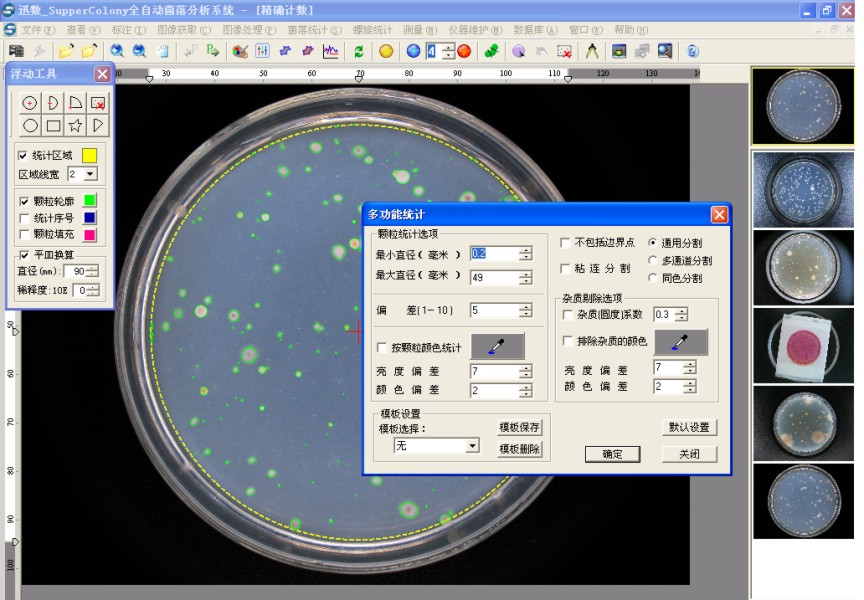
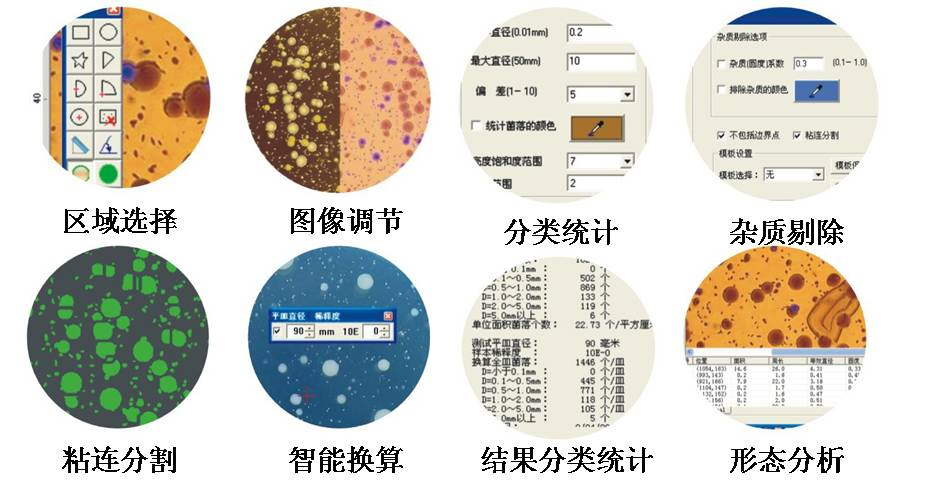
The patented Colonfast colony image intelligent recognition technology can quickly identify complex colonies, rapidly detect E. coli, Staphylococcus aureus and other strains with specific colony color and morphology on chromogenic medium, and realize automatic colony counting and colony. Morphological analysis, adhesion segmentation, automatic color recognition, automatic impurity rejection, and advanced functions such as morphological analysis, automatic conversion, measurement, and calibration. The rate of automatic colony counting was higher than 500 colonies/second, and the smallest discernible colony diameter was 0.01 mm.
2 application of microbiological microscopy
In the sewage treatment plant laboratory, the microbiological microscopy project is one of the projects that have received increasing attention in recent years. The counting and observation of microorganisms, especially the observation of indicator microorganisms, is particularly important. Indicative microorganisms are microorganisms that are easy to microscopically observe in sewage treatment and have a good reflection of the state of activated sludge. Due to the different processes of the sewage treatment plant and the different raw materials of the incoming sewage, the dominant microorganisms in the various processes of each plant are also different. The microorganisms in the activated sludge are mainly bacteria, protozoa and algae, in addition to fungi and pathogens. Bacteria in microorganisms are the protagonists of the decomposition of organic matter, and secondly, protozoa also have a certain decomposition effect. The Fast Multi-Function Bio Monitor is equipped with a powerful microscopic image analysis system that helps users to observe and count microorganisms in sewage and activated sludge.
2.1 Fast Microscopy Technology Application
The fast microscopic image analysis system consists of high-sensitivity color CMOS, powerful microscopic image analysis software and high-end microscope. It is widely used in microscopic image analysis, industrial metallographic analysis, dust and particle detection, and material microstructure. Observe and many other application areas.
2.2 Software Application
2.2.1 HD dynamic and static two-way observation

The system has "dynamic and static two-way parallel observation technology", which can easily display the dynamic microscopic image synchronously and intuitively by adjusting the microscope and CMOS, and simultaneously observe high-definition still pictures. In addition, the system has 27 image processing functions, allowing users to obtain high-quality microscopic images of targets.
2.2.2 Cell particle count
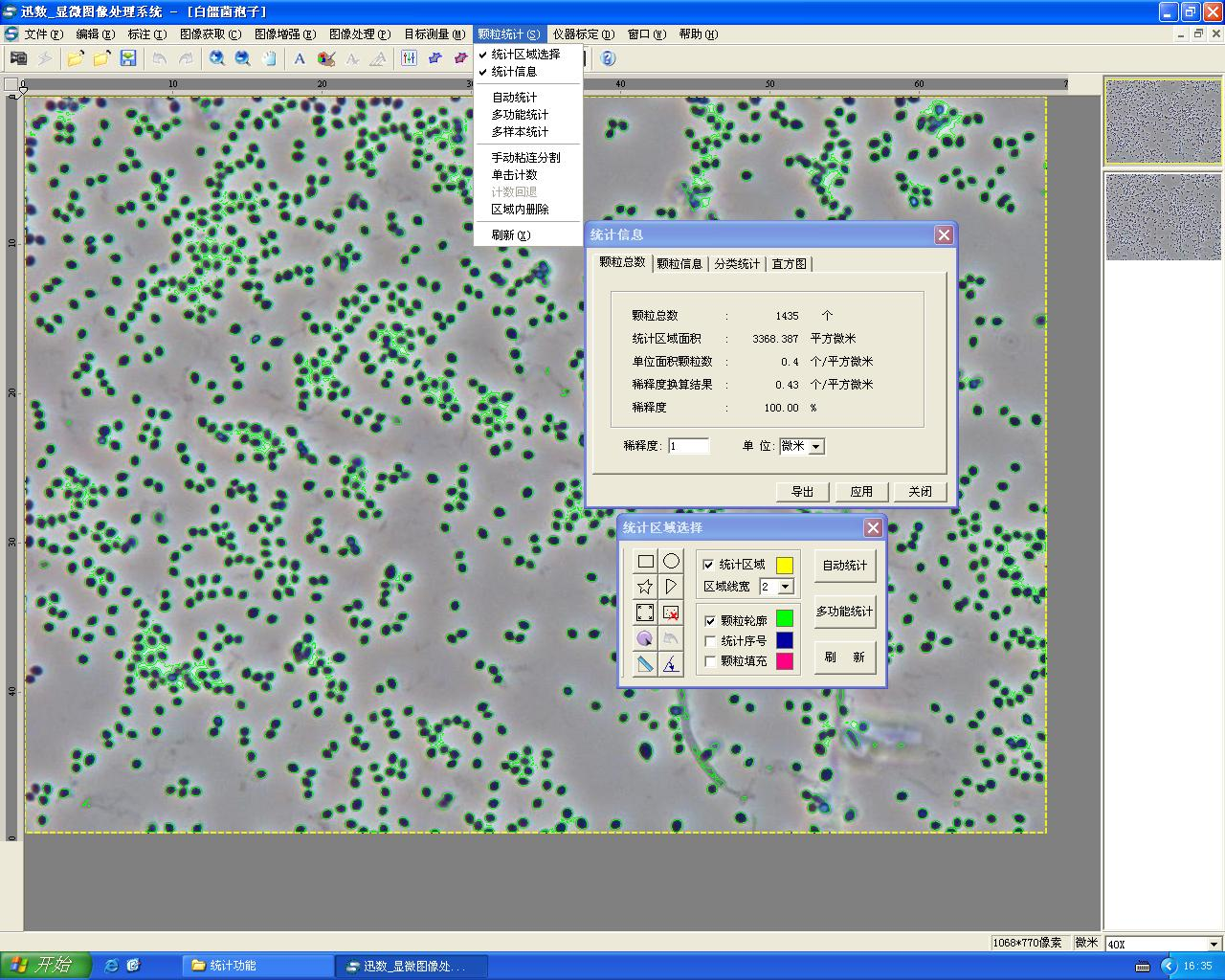
The software has automatic counting of cell particles (automatic statistics, classification statistics, color recognition statistics, regional statistics, adhesion segmentation statistics, etc.) for well-defined cells (such as cocci, bacilli, spores, etc.) or particles, which can be realized in 1 second. Automatic counting of the entire field of view. It makes up for the deficiency of the traditional artificial eye-by-count counting method, improves the statistical efficiency, makes the cell and particle counting work simple and easy, and does more with less.
2.2.3 Accurate measurement

The system is equipped with measuring tools, which can automatically analyze the diameter, area, perimeter, roundness and other parameters of the target. It can also accurately measure the characteristic parameters, such as line, angle, circle area, arc length, arbitrary curve and so on. In particular, the arbitrary curve measurement function brings great convenience to the research work of actinomycetes, molds and algae. The system can also realize the editing and embedding function of Chinese and English characters and various graphics.
3 algae observation and counting application
With the intensification of human activities, industrial wastewater, domestic sewage and nutrient elements such as nitrogen and phosphorus have entered the water body in large quantities, leading to eutrophication of water bodies, causing algae, especially some planktonic algae, to multiply and form blooms or red tides. And human life has a serious impact [4] . Therefore, the role of algae in biological monitoring has received increasing attention. As a primary producer of ecosystems, algae has made great contributions to water quality monitoring and wastewater treatment. It can sensitively and accurately detect changes in the external environment. According to the characteristics of the species and quantity of aquatic algae, the pollution of water bodies can be judged. At the same time, in sewage treatment, algae can absorb and remove harmful substances in sewage and purify water.
Algae monitoring in sewage treatment is not only an analysis of water pollution, but also an inspection of sewage purification. The multi-purpose biomonitor's algae intelligent identification and counting software enables detailed observation, identification, enumeration and analysis of algae, providing a convenient way for researchers and researchers to detect algae.
3.1 Rapid algae technology application
3.1.1 algae observation counting process
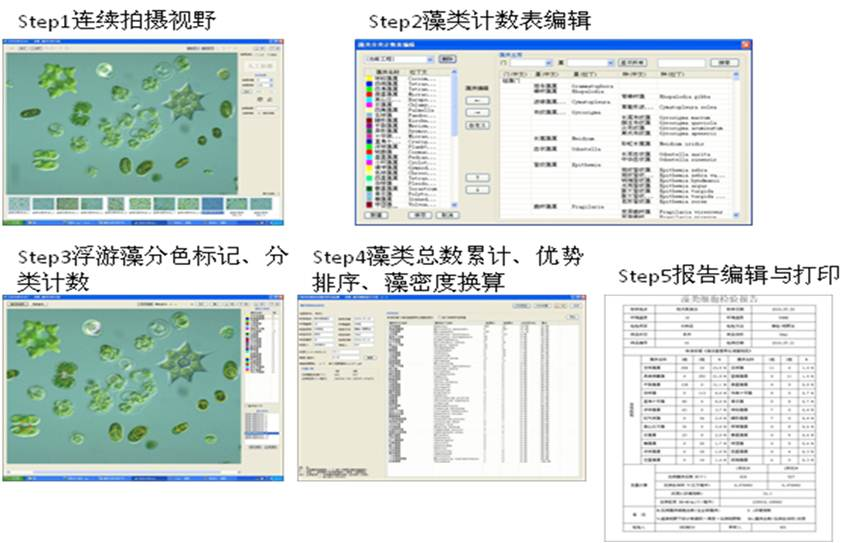
3.1.2 algae software function
The algae software contains an informative algae database. The whole library contains text descriptions, characteristic images and fine photomicrographs of 11 species, 672 genera and 3350 algae. The freshwater algae library covers seven major water systems and 28 key lakes in China. The common species, the marine algae library is mainly composed of common phytoplankton in the East China Sea, the Bohai Sea, the Yellow Sea and the South China Sea.
The software has taxonomic search, common algae search, and keyword search. The intelligent search and identification function can quickly identify the algae to be identified and the algae in the photo library through two levels of morphological search, and realize the parameters such as algae population area, cell diameter, algae filament and branching angle. Accurate measurement; automatic identification of certain unicellular algae, such as chlorella. The software includes an independent analysis module for microcystis for agglomerated algae such as Microcystis. The analysis module can automatically detect the number of cells of the microalgae, such as Microcystis, and accurately count and analyze the species.
4 zooplankton observation and counting applications
Most sewage treatment plants improve the secondary sewage treatment process through the activated sludge process. Activated sludge is a complex ecosystem of various bacteria, fungi, algae and protozoa, among which protozoa play a role in improving water quality, evaluating and indicating the operation and treatment of sewage plants. Direct observation of the species composition, quantity, and individual physiological changes of protozoa can reflect the growth and change of bacteria, that is, indirectly evaluate the quality of the sewage treatment process and treatment effect, thereby guiding the production operation.
The Fast Multi-Function Biomonitor includes professional zooplankton counting software for detailed observations of zooplankton. The software integrates more than 1,500 species of zooplankton micrographs, hand drawings and texts to assist in the identification of zooplankton species, and quickly achieve high-definition imaging, classification and counting, automatic total accumulation, and superior species sorting of zooplankton.
4.1 Application of fast zooplankton detection and analysis technology
4.1.1 Plankton counting process
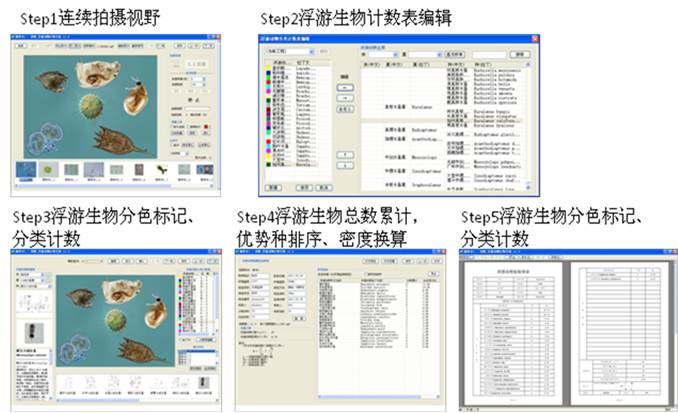
4.1.2 Zooplankton counting software function
The programmatic counting of the software can realize the classification statistics of the zooplankton, the total statistics, the automatic calculation of the dominant species and the sorting, and the abundance conversion. The database has 6 categories, 460 genera, 1500 kinds of zooplankton feature text descriptions and pictures, according to class, genus, species search and Chinese name, Latin name for quick search. The numerical scale can be used to directly measure the length and width of the zooplankton, which is convenient for the operator to directly observe and analyze the preliminary morphology of the zooplankton.
5 conclusion
Sewage treatment is a long-term and arduous task. The observation and detection of microorganisms, algae and zooplankton are important links in the biological treatment of sewage, and can make an objective and true evaluation of the treatment effect. The fast multi-function bio-monitor helps the inspection personnel to simplify and implement the high-efficiency operation of colony observation and counting, microbial microscopic analysis, algae and zooplankton monitoring, and effectively ensure the smooth progress of sewage treatment, water environmental safety assessment and sewage. Water purification provides stable and reliable data and information.
Ika Sansai,Chuka Ika Sansai Ingredients,Ika Sansai Salad,Calamari Salad Ika Sansai
DALIAN HAIBAO FOODS CO., LTD. , https://www.haibaoseafoods.com